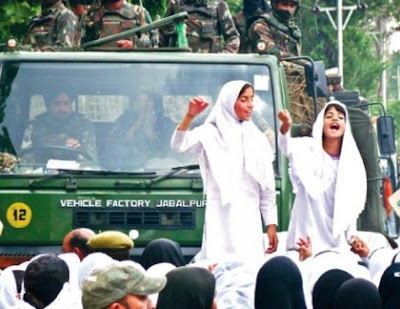Although U.S. military policy prevents women from taking certain war zone assignments, they are increasingly filling dangerous jobs in Iraq and Afghanistan. An author, Army sergeant and retired Navy captain discuss the changing role of women in combat.
One more casualty of the war in Iraq brought home to Decatur, Illinois, last weekend. In this case, the soldier's vehicle was hit in Baghdad on June 21st by a rocket-propelled grenade. But this death is one of those that makes this war unique, for it was a woman, 22-year-old Army Specialist Karen Clifton.
She is one of the most recent of more than 80 women who have so far been killed in Iraq and Afghanistan, a figure nearly double the number of American military women killed in Desert Storm, Vietnam, and Korea, combined. Some 500 have been wounded, many grievously.
American women are serving in the U.S. military today in ways and numbers unthinkable a few decades ago. They are now eligible to fill more than 80 percent of military jobs, 250,000 different assignments, often serving side-by-side with men.
So far, women have served some 167,000 tours of duty in the wars in Iraq and Afghanistan, more than four times the number in the first Gulf War. They are not assigned to infantry units, to tanks or submarines, and Pentagon policy officially precludes them from serving in so-called "combat occupations." But in the Iraq and Afghanistan wars, where no clear frontlines exist, such distinctions are often hard to make.
Women in both theaters today drive Humvees and trucks, escort military convoys, serve as military police, even pilot helicopters and planes on the battlefield, all of it done under the very real -- and constant -- threat of attack. And like men, many women of the U.S. Armed Services have by now served several tours in the war zones.

More roles for women
JUDY WOODRUFF: For more, I'm joined now by: Kirsten Holmstedt, author of "Band of Sisters," a book profiling 12 female soldiers and Marines during their tours in Iraq; Carolyn Schapper, a sergeant in the Virginia Army National Guard, she participated in nearly 200 combat missions in Iraq from October 2005 to September 2006, as part of a tactical human intelligence team; and Lory Manning, she is a retired U.S. Navy captain and director of the Women in the Military Project at the Women's Research and Education Institute, a public policy research group in Washington.
Thank you all three for being with us.
And, Kirsten Holmstedt, I want to begin with you. You're the one who's written the book about this. Why are there more women serving now in the military?
KIRSTEN HOLMSTEDT, Author, "Band of Sisters": Well, I think because there are so many more roles open to women in the military, and they're serving, like you said in the opening, they're serving on trucks. They're driving trucks. They're pilots. They're medics. More than 80 percent or 90 percent of the positions are open to women now, so they're all over the battlefield.
JUDY WOODRUFF: And women are enlisting to fill these positions?
KIRSTEN HOLMSTEDT: They are, absolutely.
JUDY WOODRUFF: And in the numbers the military is looking for or is there a way to tell?
KIRSTEN HOLMSTEDT: Well, I think they'd like more men and women, but there are many, many women in the military now.
JUDY WOODRUFF: Captain Manning, what are the jobs these women are doing? How has their role changed from what it used to be?
LORY MANNING, Retired U.S. Navy Captain: Well, they used to be mostly not in a combat zone, except for the medical women, the nurses, the physicians, that's how it was, say, in Vietnam. During Gulf War in the early '90s, we used a lot more women, but not on the frontlines.
There are a lot more women in the military now since the changes that were made after the Gulf War, and women are doing what they call "combat support jobs," driving trucks near the front line, MPs, those sorts of things.
One of the reasons we're seeing them in so many roles now and so many casualties is because there is no frontline in this war. It a whole different kind of war than the U.S. has fought before and because the laws and the policies have changed, that changed in the mid-'90s.
JUDY WOODRUFF: Help us understand a little bit better about what is permitted, in terms of the roles that women may fill, and what's not permitted?
LORY MANNING: That's a good question. And allow me a little time, because there are some little complexities. The basic policy comes from a memo written in 1994 by the secretary of defense. And it says, "Women can serve in any role in the military except for units smaller than brigades" -- so those are things like battalions or companies -- "that have a primary mission of ground combat," which boils down to infantry, tanks, short-range field artillery and special forces.
And that's the basic secretary of defense level, but each service refines it. And what the Army did, and to an extent the Marine Corps, is say, "We're going to narrow it a little bit further and say that women also cannot serve in units or positions who normally would co-locate with infantry units." That's a very technical term, co-locate.
JUDY WOODRUFF: Meaning live with?
LORY MANNING: Live with, essentially meaning a woman medic can't be serving with the infantry. That's the thing that has gotten so garbled in Iraq; it's impossible to really enforce that.
Handling dangerous situations
JUDY WOODRUFF: And, Kirsten Holmstedt, what we're talking about, then, is, yes, there are restrictions, but women are doing so many of these jobs, and they're firing weapons.
KIRSTEN HOLMSTEDT: And they're co-locating, just like she said.
JUDY WOODRUFF: They are co-locating, you're saying?
KIRSTEN HOLMSTEDT: Yes, yes.
JUDY WOODRUFF: Meaning they're living, they're in the same...
KIRSTEN HOLMSTEDT: The first story of my book is about two young women, lance corporals in a Marine Corps, who were in a firefight. They attached, I think is the word they used, to an infantry unit so that they could help the infantry when they went house-to-house to search women and children. And so they co-located, and they stayed in the same house or they stayed outside with them, wherever they were sleeping.
JUDY WOODRUFF: Carolyn Schapper, you were in Iraq, we said, from 2005 to 2006. What did you do? What was your assignment? And was it clear to you going in that you were going to be how close to combat or not?
CAROLYN SCHAPPER, Sergeant, Virginia Army National Guard: I'll start with the second part first. I was aware that there was never any surprise that military intelligence, which is what I do, goes out and talks to the locals. And that was my primary mission, was to talk to the local people and find out what their concerns and address those issues.
JUDY WOODRUFF: And that meant, what, you were armed?
CAROLYN SCHAPPER: I was armed. I would go out almost every day, and I would go into the villages and the cities, and get out of my truck, and walk into their homes.
JUDY WOODRUFF: And you were in dangerous situations.
CAROLYN SCHAPPER: Yes, I was.
JUDY WOODRUFF: How often?
CAROLYN SCHAPPER: Oh, every day is a dangerous situation. You never know what's going to happen. But I had seven significant events occur to me. That includes IEDs, sniper fire, and mortars, not to me personally, to my team.
JUDY WOODRUFF: And how did you -- do you think that you and other women you were alongside in Iraq deal with these things differently from the men?
CAROLYN SCHAPPER: Your training comes into play. I'd say you almost have a lack of emotion. You do what you need to do to get your people out and safe and back to the base or take care of the enemy. But, unfortunately, there's rarely an enemy to take care of.
And I would assume that's true for every individual, not necessarily a woman or a man, that your emotions are put aside and your training comes to the front.
JUDY WOODRUFF: Even when your comrades are hurt?
CAROLYN SCHAPPER: Yes, even more so, I would say so, because your first priority is to make sure they're safe.
Acceptance of women
JUDY WOODRUFF: Captain Manning, what does your research show? How are women doing in these jobs?
LORY MANNING: That's the biggest surprise of the war. Before this, people only guessed, and they guessed that the women would fall to pieces, that they wouldn't be able to rescue fallen comrades, that, if they were shot at, they wouldn't be able to shoot back because they'd be so nervous.
None of those bad guesses that women would go to pieces have happened: The women have held their own. They've done brilliantly well. And there's been no obvious differences, either over in Iraq or when people come back, the women's rates of post-traumatic stress disorder and those sorts of things are not that different from the men's. So what we have learned is, through real experiences, that women can hack it in the military.
JUDY WOODRUFF: And, Ms. Holmstedt, how are the men who, of course, make up the vast majority, how are they receiving, how are they accepting or not these women?
KIRSTEN HOLMSTEDT: That's interesting, because I think, no matter what their age, you will find men who accept the women and find men who don't accept the women. I've talked to young lance corporals, male lance corporals and corporals, who don't accept the women and some who do, all the way up to generals, some who do accept women and some who don't.
JUDY WOODRUFF: What do you mean by accept and not?
KIRSTEN HOLMSTEDT: Well, I talked to one general on the phone, and he said that, at a cocktail party, he might say that he's opposed to women in combat and doesn't like it, but, really, he does believe in women in combat and he thinks they're doing wonderful things.
So there is an outward support or lack of support. There's a contradiction right now. I just think people are really -- some men, and the ones who have been around for a while in the military, the older echelon -- I think they're more resistant to supporting women openly. And I think that that reflects all the way down, because women are still, I believe, treated like second-class citizens because of that male mentality.
JUDY WOODRUFF: Well, let me ask Ms. Schapper. Was that your experience? Were women treated differently? Were you treated like second-class citizen or not?
CAROLYN SCHAPPER: It depends who I was working with. Within my team, which was other military intelligence and the infantry that worked for us, no, we were team members. We rely on each other. You can't think anybody is not going to save your life if necessary. So there was a lot of mutual respect within my team.
But since I was on a small infantry base, I did have difficulties at first with the commanders I had to go brief or get debriefed by. But, over time, I proved myself.
JUDY WOODRUFF: Difficulties in what way?
CAROLYN SCHAPPER: Just that I didn't really know what I was talking about maybe because I was a female. But it all turned around one day when one of my gunners got shot, and I took command of the convoy to get him back. And I got high praise from the infantry sergeant major when we got back, and that's when it turned around. So I had to prove myself to them that I was capable of doing the same job as a man.
JUDY WOODRUFF: How much of an issue -- you mentioned in our talking with you ahead of time sexual harassment to some degree for the women. How much of a problem is this, do we know, Captain Manning?
LORY MANNING: We know it's a problem, but I don't think we have any idea to what extent. It's a problem for women of that age group on college campuses, no matter where they are. And it's more difficult to deal with over there, because particularly when it gets to full-blown sexual assault, you need to be able to have the evidence to prosecute a criminal in a court. And that has caused problems. I don't think it's like half the women over there or anything of that extent, but nobody knows for sure.
The future of women in combat
JUDY WOODRUFF: What do you see, just quickly, Captain Manning, for the future? I mean, does this mean that women are now inevitably going to be fighting wars?
LORY MANNING: It's inevitable, and it's not happening just in the U.S. There have been British women, Australian women, Ukrainian women in Iraq, a lot of Canadian women in Afghanistan. It's going on around the world, and, yes, they're going to be fighting wars, because they can. And most countries these days have all-volunteer forces, so that's who's volunteering.
JUDY WOODRUFF: And, Ms. Holmstedt, the restrictions that exist, are they the kind -- do you think they'll stay?
KIRSTEN HOLMSTEDT: Maybe those restrictions for a little longer, but I think women are really -- they like the roles that they're in right now. And some definitely want to push the boundaries. I've talked to some who...
JUDY WOODRUFF: Some women who want to do more, you mean?
KIRSTEN HOLMSTEDT: Some women who want to possibly be in infantry. But a lot of the women who are in the roles that they're in right now are very happy with those roles, as MPs and pilots and medics and logisticians.
JUDY WOODRUFF: Captain Manning, the fact that women can't technically, by the rulebook, serve in combat, how does that affect their ability to move all the way up through the ranks, to serve in the highest ranks of the military?
LORY MANNING: Well, it's not a factor at all for Air Force or Navy women, because they can, in fact, serve in every aspect of combat in those services. It is a factor for Marine Corps and Army women who might want to be, say, the command sergeant major of the Marine Corps or chief of staff of the Army without a combat specialty. That's not going to happen.
JUDY WOODRUFF: Mrs. Schapper, I'm going to give you the last word. What should the public know about what women are doing in Iraq and Afghanistan right now?
CAROLYN SCHAPPER: Women are doing the same jobs as men, the majority of the time, and they're doing them very well.
JUDY WOODRUFF: Well, thank you all three, Ms. Holmstedt, Ms. Schapper, and Captain Manning, thank you very much, all three of you.






































































